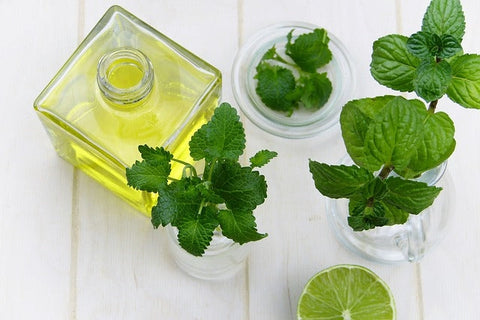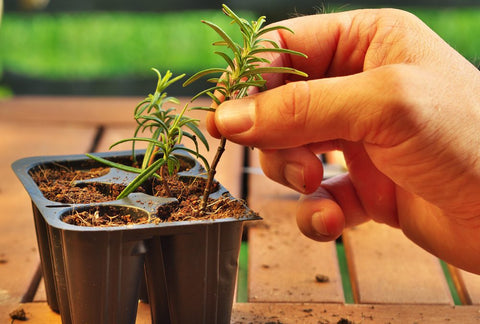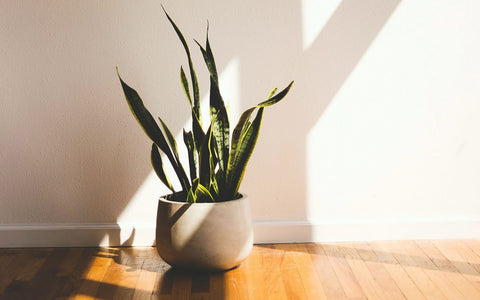Whether you’re just headed away for the weekend or leaving your plants behind for a week-plus trip, the interruption of your usual care & maintenance routine does present a risk to your indoor garden.
In this article, we will discuss a few no-cost tricks you can use to ensure the health of your garden while you’re away, as well as recommend a few affordable products that make the task that little bit easier.
Why adjust the lighting on herbs while traveling?
Light is obviously an essential part of long-term plant health. Light is the source of energy plants use to fuel their growth. Generally speaking, the more light your plants have access to the faster they will grow. That’s usually a good thing, but more growth means they are also consuming more water.
If you’re traveling for an extended period of time, we actually recommend you reduce your indoor herb gardens’ exposure to light. This might mean moving it away from the window, or reducing the number of hours per day by up to 75% or more.
This reduction in light will not only keep your garden cooler (reducing evaporation) but it’s also going to slow down its growth. That means the herb garden will consume water slower - which is particularly important if you’re not around to top it up!
To Keep Your Herbs Alive, They Would Need Moisture
Your indoor herbs, like your basil and cilantro plant, need water while you are gone so they can be kept alive. Simply overwatering them once before you leave won’t work. You should water them, of course, but take the time to set up a self-watering system and provide a way to conserve moisture and prevent evaporation.
Here are a few low-cost ways you can preserve the moisture in your indoor garden while traveling.
Make A Plastic Bag “Greenhouse” For Smaller Herbs
Greenhouses don’t need to be fancy glass containers. A simple plastic shopping bag from the grocery store will work well enough. Up-end the bag over your pot and prop it up on skewers or chopsticks to keep it from touching the top leaves of your plant. Seal the bag closed with a large rubber band or string.
If your herbs are too large to fit under a plastic bag, there are some other things you can do to conserve moisture.
Create A Moisture Trap With A Pebble Tray
To create your moisture trap, you’ll need to:
- Create a moisture trap by putting tiny pebbles into a shallow tray (like a baking pan) and filling it with water so that the water just covers the rocks.
- Place your pots on top of this. The water will be able to travel up the drainage holes of the pot as needed when the potting soil gets too dry.
- Use small pebbles; water won’t travel easily from large rocks.
Create A Moisture Trap With Wet Towels Or Newspaper
If you’re short on trays and rocks, wet a towel and place it under your pots instead. Do this in a bathtub or sink so that the water doesn’t leak all over the floor. As an alternative, wet newspaper or paper towels and cover the soil. The newspaper will keep prevent evaporation as well as provide some moisture.
Set Up A Self-Watering System to Keep Your Herbs Alive
After setting up moisture conservation, set up this self-watering system.
- Fill a plastic jug with good water and place it near your plants.
- Cut a length of cord or twine that will stretch easily, but not limply, from the jug to the pot. One end should be a few inches underwater and the other end should be resting in the pot. The cord/twine should be a natural or otherwise porous material so that water can travel through it. Plastic, for instance, will not work.
- Use a small rock or heavy object to hold down the end of the twine in the pot.
- Place a strip of duct tape over the mouth of the jug so the water doesn’t evaporate and the other end of the twine doesn’t slip out.
- Water will travel through the cord/twine by cohesion. Water molecules tend to stick to each other, and as long as there is room for them to move, they will continue traveling. Water will seep from the jug down the cord into your pot. You will be able to tell that the water is traveling if the cord is wet, so it’s a good idea to set this up a few days in advance to make sure it’s working before you leave.
Other Self-watering Systems You Can Create to Keep Your Herbs Alive
If you don’t have the time or resources to create the above self-watering system, you can also try looking into an olla, plant watering spikes, or just use terracotta pots and plug the drainage holes with a cork.
- Olla irrigation
Olla irrigation is a simple technique that is both cheap and easy to do. Ollas are buried in soil and filled with water. Dry soil then pulls the water through the porous unglazed pots, moistening the soil surrounding the olla which irrigates the plants. These are perfect to use to keep your herbs watered and alive while you travel.
From wikipedia.org, an olla is a ceramic jar, often unglazed, used for cooking stews or soups, for the storage of water or dry foods, or for other purposes like the irrigation of olive trees. Ollas have short wide necks and wider bellies, resembling beanpots or handis.
We were not able to get any decent licensed photo to show you what an olla looks like, but hopefully, this short description from Wikipedia gives you an idea. Ollas used for irrigation come in smaller sizes, so they are like plant watering spikes in the shape of miniature pots.
- Clay terracotta pots
You can also just use normal clay terracotta pots, put a cork to plug the drainage hole, then fill it with water.
The bottom line here is that terracotta is a really handy material for self-watering setups. There are no mechanical or electrical parts to break, it needs no energy to run, and just utilizes the porosity of the material to slowly release water into the surrounding soil.
Here are a few terracotta-based passive self-watering solutions you will find online.
|
|
|
Self-Watering Bottle Gardens
Another way to help your garden thrive while you’re away is to set up a simple Kratky-style hydroponic setup. The nice thing about hydroponics is that you create a way for the plants to water themselves (so you don’t have to!).
The Urban Leaf Bottle Garden Kits are a good example of this. Essentially the product sets up a way for plants to water themselves, so you don’t have to.
Hopefully, this article has helped you identify some solutions that will work for both you, and your plants, during your upcoming trip. If you’d like to learn more about Edible Indoor Garden and other tricks to success, then feel free to grab a copy of our eBook below.














There are no comments for this article. Be the first one to leave a message!